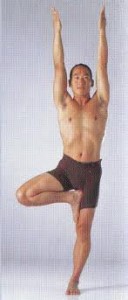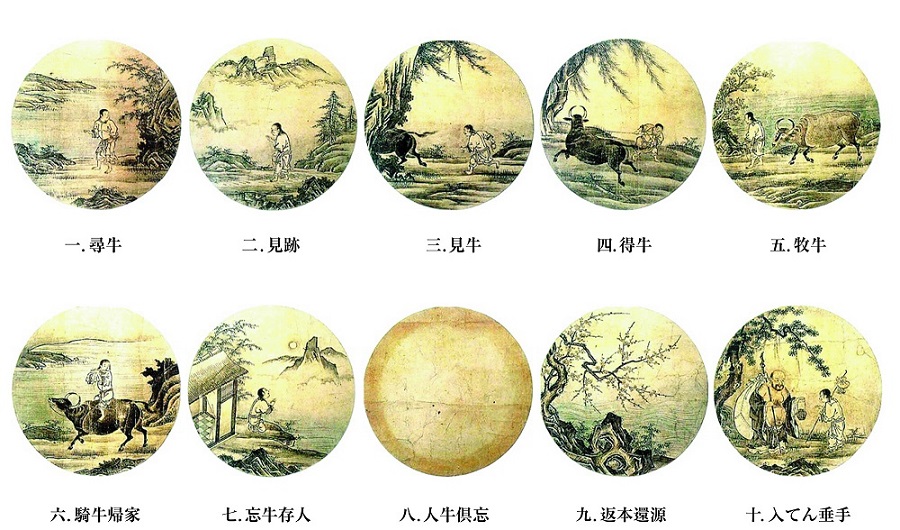Lesson 5
Lateral Flexion and Extension, or the Fish Body
Starting in skiers tadasana, find the balance of weight and lightness as a current of energy flowing through you. Relax into ground and feel/sense/see the space around you. Feel alive and present. In the previous lesson, we examined the act of bending forward and coming back up right and discoverd that if the legs stay engaged and alive, the pelvis moves though space and the body feel safe as it moves up and down. No unnecessary tension arises and the movements are effortless. Now we will explore a different pelvic action: lateral flexion and extension.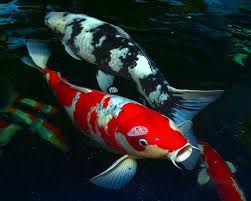
Mammals primary movements come from what is known as sagital flexion and extension, or what in yoga is called forward and backward bending. Our ancestors, the reptiles, amphibians and fish use a different action. They move sideways, or what we will call lateral flexion and extension or the fish body move. The primary pose here is trikonasana, the triangle pose. Out of this basic action we will explore three related poses, side angle, warrior II, half moon and tree pose.
Trikonasana
As previousy noted, all the structures of the feet are involved in providing a stable base. Here we begin with a wide stance, 3- 4 ft apart, or about the length of your legs, so you create a triangle with the two feet and the base of the spine as the three corners. Because side bending of the spine is much more natural than in the pelvis, the yogis adapted the triangle by turning one foot 90 degrees out (the front foot) and one 60 degrees in (the back foot). See photo.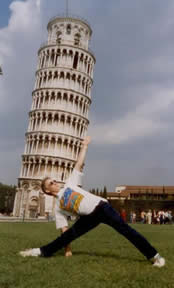
Now imagine your tail is long like a fish, extending to the floor between your legs. Keeping your legs relatively straight, as best you can swing the tip of your tail toward and beyond the back leg and let the pelvis follow along an arc, when you get to the end of the movement, pause and return back to the beginning, like the swinging of a pendulum. Repeat again several times and then change sides. Be careful of the front knee. Do not try to ‘square the hips’!! You will damage your sacro-illiacs sooner or later. Liberate your fish tail instead.
Parsvakonasana and Virabhadrasana II
The next posture is a continuation of the trikonasana action with an additional piece. As you swing the tail and let the pelvis follow, allow the front knee to bend, moving on a straight line toward the front foot. The tarsals and metatarsals of the front foot ground the energy firmly into the floor, with almost no weight on the hell. This will protect the knee. Also, the front knee should never extend beyond the ankle and should not wobble or veer inward. This is the fork in the road between two more challenging postures, the side angle pose and warrior II. 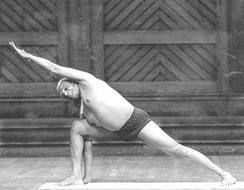 Beginners can pause here and then reverse, moving as smoothly and slowly as possible in and out of the pose. Repeat the action several times and then change sides. This brings us back to our first asana mantra which is “Not the Knees!” As mentioned before we all have an unfortunate tendency to use the knees inappropriately. Let the knees be receptive and supported by the feet.
Beginners can pause here and then reverse, moving as smoothly and slowly as possible in and out of the pose. Repeat the action several times and then change sides. This brings us back to our first asana mantra which is “Not the Knees!” As mentioned before we all have an unfortunate tendency to use the knees inappropriately. Let the knees be receptive and supported by the feet.
More experienced students can explore the side angle pose by deepening the circular action of the groin so that the whole torso drops onto the front thigh. The arms can extend as seen, or explore other possibilities, such as imagining picking up a sock from the floor with your hand, and then placing it back down again.
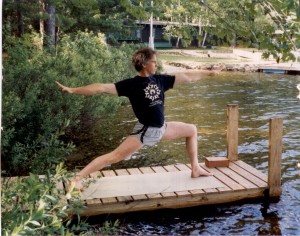 In Virabhadrasana II we find the third pose in this grouping of fish body postures. It begins with the trikonasana action of extending into the back leg and the parsvakonasana action of simultaneously extending the front groin. Then, instead of going deeper into parsvakonasana by lengthening the groin even further, we circle up and out from the groins through the arms, like a fencer or an archer. Again, to learn the healthy action, do not stay in the pose but slowly, gracefully, effortlessly move in and out of the pose. Notice the break of energy along the deep front line of the right side between the groin and torso in the student on the dock.
In Virabhadrasana II we find the third pose in this grouping of fish body postures. It begins with the trikonasana action of extending into the back leg and the parsvakonasana action of simultaneously extending the front groin. Then, instead of going deeper into parsvakonasana by lengthening the groin even further, we circle up and out from the groins through the arms, like a fencer or an archer. Again, to learn the healthy action, do not stay in the pose but slowly, gracefully, effortlessly move in and out of the pose. Notice the break of energy along the deep front line of the right side between the groin and torso in the student on the dock.
Ardha Chandrasana  Coming into the half moon pose or ardha chandrasana involves a continuation of the actions of trikonasana and parsvakonasana.
Coming into the half moon pose or ardha chandrasana involves a continuation of the actions of trikonasana and parsvakonasana. 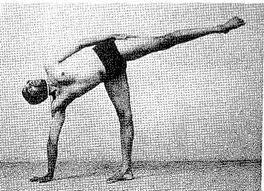 The primary fulcrum or hinge is the front leg hip joint. The supporting energy flow comes from the standing foot. Then we find the see saw action where the action of the back leg extending balances the torso.
The primary fulcrum or hinge is the front leg hip joint. The supporting energy flow comes from the standing foot. Then we find the see saw action where the action of the back leg extending balances the torso.
From triangle, release the front knee forward like parsvakonasna, extend the front hand out while simultaneously lengthening out through the back leg. A simple pivot brings you into the pose. Practice coming in and out, staying low to the ground, in the beginning. Find the balance and fluidity. In figure skating, this is called a forward spiral, here down by Tara Lipinsky. We will use ardha chandrasana as the starting pose for our exploration of twisting poses in the next lesson.
Tree pose is another fish body pose. (Thanks to Rodney for an elegant demonstration.) Because the front or bent leg is turned out as in the previous poses, the bent leg foot can provide leverage to open the pelvis sideways. To find balance the weight has to shift slightly to the left and this can open the left groin. Notice the nice long line of energy from his inner left foot to the inner left palm. Tree pose can be used to learn the deeper action in trikonasana because the leverage in triangle is where the foot presses the thigh in tree.


